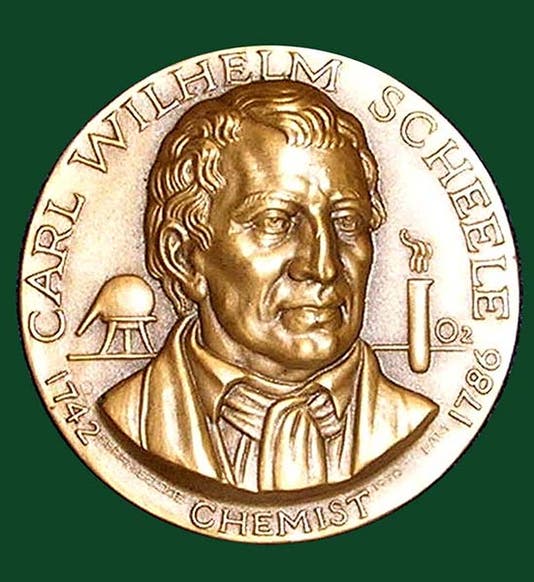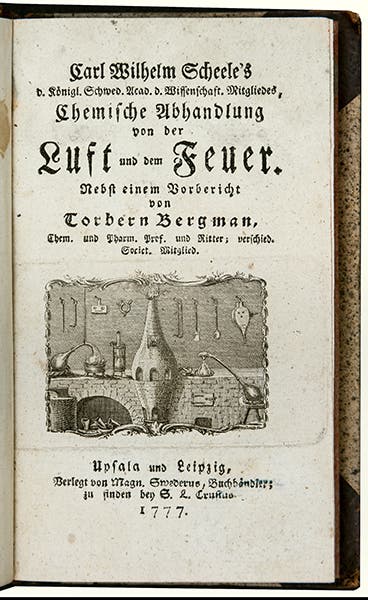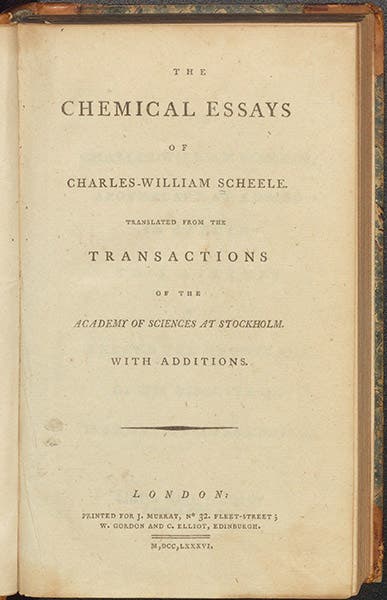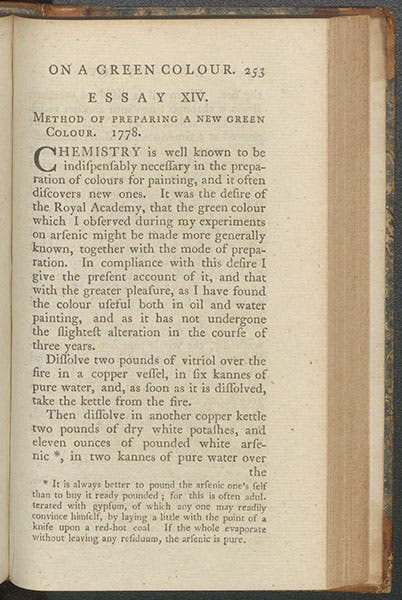Scientist of the Day - Carl Wilhelm Scheele
Carl Wilhelm Scheele, a Swedish pharmacist, was born Dec. 9 (or possibly Dec. 19), 1742. Scheele's family was unable to send him to the university, so he was apprenticed to a pharmacist in Gothenburg, who kindly gave Scheele the opportunity to experiment with chemicals, which became his lifelong passion, and which he continued to pursue after he established himself as a pharmacist in Stockholm, Uppsala, and Köping. He was remarkably good at chemical synthesis, discovering quite a few new compounds, including a variety of organic and inorganic acids.
Scheele, like many chemists of his day, subscribed to the phlogiston theory of combustion, which colored his interpretation of many of his discoveries. According to the phlogiston theory, a material burns when it gives off phlogiston, which was considered an element and was represented by the symbol Φ (phi). A metal rusted when it gave off phlogiston, so with the phlogiston theory, an oxide (called a calx in Scheele's day) was a purer substance than a metal, which was a calx combined with phlogiston. This was just the reverse from modern explanations of combustion, where we understand that a substance (oxygen) is taken on when an element burns, or when a metal rusts (oxidizes). The phlogiston theory was quite successful in accounting for most chemical reactions, except for the fact that a metal gets heavier when it gives off phlogiston and forms a calx, which implies that phlogiston has negative weight. When Scheele discovered chlorine in 1774, he called it “dephlogisticated muriatic acid air,” muriatic acid being the name for what we would call hydrogen chloride in an aqueous solution.
Sometime in 1771 or 1772, Scheele made his most famous discovery. He was interested in air, because it is a necessary ingredient in most kinds of combustion or calcination. It was strongly suspected by 1770 that air was not a monolithic element. Joseph Black had already in 1756 discovered that ordinary air contains something he called fixed air, which would not support combustion and was soluble in water. We would call it carbon dioxide. Others had noticed that when you burn a candle in a closed space, eventually it will burn no longer, suggesting that some part of the air is used up in combustion, leaving a part that will not support combustion. Scheele was interested in isolating the "good air," which supports life and combustion. He discovered several reactions by which he could produce and isolate "good" air. For example, if you heat up niter (potassium nitrate), it will produce red fumes and something else, and if you pass the resulting gas over slaked lime (calcium hydroxide), the red fumes are absorbed, and the "someting else" can be collected in a bladder. A candle burns very strongly in this gas, and it supports combustion and life. Scheele called his good air: Feuer Luft, "Fire-Air." We would call it oxygen, and Scheele was the first to discover it. Unfortunately, he did not get around to announcing the discovery until 1777, when he published a book, Chemische Anhandlung von der Luft und dem Feuer. By that time, Joseph Priestley in England had already (1774) discovered oxygen on his own, and so had Antoine Lavoisier, possibly on his own, with Priestley usually receiving the credit. Scheele also was the first to isolate the bad air, which he called verdorbene Luft, spoiled air, and we would call nitrogen. But because his book appeared so late, Daniel Rutherford, who discovered nitrogen independently in 1772, is usually given the credit for that gas.
We do not have Scheele’s 1777 book in our collections, so we show you the titlepage of a copy being offered for sale by a rare book dealer in New York City. We do have a volume containing English translations of many of the papers that were given by Scheele to the Royal Academy of Sciences in Stockholm. The papers were translated by Thomas Beddoes. We show here the title page (third image), and the beginning of one of Scheele’s papers, on “Pure air,” read to the Academy in 1779 (fourth image). We also have a French collection of these same Scheele papers, translated by Claudine Picardet and published in 1785. You can see the title page of this edition in our post on Picardet.
One of Scheele’s discoveries later achieved some notoriety. He found that when you combine potash, copper sulfate, and arsenic under certain conditions, you can produce a green pigment, which we might call copper arsenite. It turned out to be a very durable pigment (many greens tended to either fade or darken), as Scheele had already come to appreciate when he gave a paper on his discovery to the Academy (fifth image). Scheele’s green, as it is still called, became popular in the 19th century with both artists and wall-paper manufacturers. It wasn’t until mid-century that it was realized that rooms papered with Scheele’s green wallpaper (see the sixth image for an example) were not conducive to good health. Scheele’s green was at one time blamed for the death of Napoleon (his house of confinement on St. Helena had green-wallpapered rooms), but it is now thought that there were many other ways that Napoleon could have built up the high level of arsenic that was found in his remains. It is more likely that arsenic exposure, along with exposure to mercury and lead, contributed to Scheele’s own death in 1786, at the young age of 43.
There are no truly satisfactory portraits of Scheele, which is not surprising, given his pharmaceutical profession and his early death. Most of what we have might be called “likenesses” rather than portraits. We show you one of those, a portrait medal (first image). Several statues of Scheele have been erected, in Stockholm, and in Köping, where he lived his last few years and died, but they are no better as portraits than the medals and reliefs. You can see the Köping statue here.
William B. Ashworth, Jr., Consultant for the History of Science, Linda Hall Library and Associate Professor emeritus, Department of History, University of Missouri-Kansas City. Comments or corrections are welcome; please direct to ashworthw@umkc.edu.












